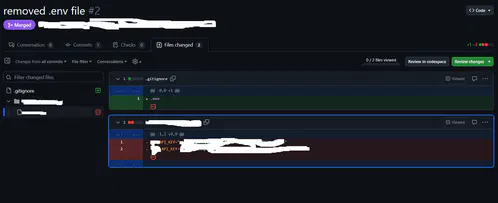Background: 15 years of experience in software and apparently spoiled because it was already set up correctly.
Been practicing doing my own servers, published a test site and 24 hours later, root was compromised.
Rolled back to the backup before I made it public and now I have a security checklist.
Although disabling the root user is a good part of security, leaving it enabled should not alone cause you to get compromised. If it did, you were either running a very old version of OpenSSH with a known flaw, or, your chosen root password was very simple.
The latter. It was autogenerated by the VPS hosting service and I didn’t think about it.
It should be a serious red flag that your VPS host is generating root passwords simple enough to get quickly hacked.
I’m pretty sure they assumed if you bought their service, you have the competency to properly set it up.
And I proved them wrong.
I like to spin up a public facing server and run tcpdump
Lol! Honeypot or just bored?
Actually I was troubleshooting a Firewall issue on site. I just forgot to use the filter arguments to reduce the output.
Oooof, I know that feeling.
I’m having the opposite problem right now. Tightend a VM down so hard that now I can’t get into it.
Interesting. Do you know how it got compromised?
I published it to the internet and the next day, I couldn’t ssh into the server anymore with my user account and something was off.
Tried root + password, also failed.
Immediately facepalmed because the password was the generic 8 characters and there was no fail2ban to stop guessing.
I ran a standard raspian ssh server on my home network for several years, default user was removed and my own user was in it’s place, root was configured as standard on a raspbian, my account had a complex but fairly short password, no specific keys set.
I saw constant attacks but to my knowledge, it was never breached.
I removed it when I realized that my ISP might take a dim view of running a server on their home client net that they didn’t know about, especially since it showed up on Shodan…
Don’t do what I did, secure your systems properly!
But it was kinda cool to be able to SSH from Thailand back home to Sweden and browse my NAS, it was super slow, but damn cool…
Why would a Swedish ISP care? I’ve run servers from home since I first connected up in … 1996. I’ve had a lot of different ISPs during that time, although nowadays I always choose Bahnhof because of them fighting the good fights.
They probably don’t, unless I got compromised and bad traffic came from their network, but I was paranoid, and wanted to avoid the possibility.
wow crazy that this was the default setup. It should really force you to either disable root or set a proper password (or warn you)
Most distributions disable root by default
Which ones? I’m asking because that isn’t true for cent, rocky, arch.
we’re probably talking about different things. virtually no distribution comes with root access with a password. you have to explicitly give the root user a password. without a password no amount of brute force sshing root will work. I’m not saying the root user is entirely disabled. so either the service OP is building on is basically a goldmine for compromised machines or OP literally shot themselves in the root by giving root a password manually. something you should never do.
Yeah I was confused about the comment chain. I was thinking terminal login vs ssh. You’re right in my experience…root ssh requires user intervention for RHEL and friends and arch and debian.
Many cloud providers (the cheap ones in particular) will put patches on top of the base distro, so sometimes root always gets a password. Even for Ubuntu.
There are ways around this, like proper cloud-init support, but not exactly beginner friendly.
#no thank you lol
Mostly Ubuntu. And… I think it’s just Ubuntu.
Ah fair enough, I know that’s the basis of a ton of distros. I lean towards RHEL so I’m not super fluent there.
Fedora (immutable at least) has it disabled by default I think, but it’s just one checkbox away in one of the setup menus.
Standard Fedora does as well
Rocky asks during setup, I assume centOS too
Now that you mentioned it, it didn’t! I recall even docker Linux setups would yell at me.
Love Hetzner. You just give them your public key and they boot you into a rescue system from which you can install what you want how you want.
I think their auction servers are a hidden gem. I mean the prices used to be better. Now they have some kind of systrem that resets them when they get too low. But the prices are still pretty good I think. But a year or two ago I got a pretty good deal on two decently spec’d servers.
People are scared off by the fact you just get their rescue prompt on auctions boxes… Except their rescue prompt has a guided imaging setup tool to install pretty much every popular distro with configurable raid options etc.
Yeah, I basically jump from auction system to auction system every other year or so and either get a cheaper or more powerful server or both.
I monitor for good deals. Because there’s no contract it’s easy to add one, move stuff over at your leisure and kill the old one off. It’s the better way to do it for semi serious stuff.
because the password was the generic 8 characters and there was no fail2ban to stop guessing
Oof yea that’ll do it, your usually fine as long as you hardened enough to at least ward off the script kiddies. The people with actual real skill tend to go after…juicer targets lmao
Haha I’m pretty sure my little server was just part of the “let’s test our dumb script to see if it works. Oh wow it did what a moron!”
Lessons learned.
Lol ssh has no reason to be port exposed in 99% of home server setups.
VPNs are extremely easy, free, and wireguard is very performant with openvpn also fine for ssh. I have yet to see any usecase for simply port forwarding ssh in a home setup. Even a public git server can be tunneled through https.
Yeah I’m honest with myself that I’m a security newb and don’t know how to even know what I’m vulnerable to yet. So I didn’t bother opening anything at all on my router. That sounded way too scary.
Tailscale really is magic. I just use Cloudflare to forward a domain I own, and I can get to my services, my NextCloud, everything, from anywhere, and I’m reasonably confident I’m not exposing any doors to the innumerable botnet swarms.
It might be a tiny bit inconvenient if I wanted to serve anything to anyone not in my Tailnet or already on my home LAN (like sending al someone a link to a NextCloud folder for instance.), but at this point, that’s quite the edge case.
I learned to set up NGINX proxy manager for a reverse proxy though, and that’s pretty great! I still harden stuff where I can as I learn, even though I’m confident nobody’s even seeing it.
Honestly, crowdsec with the nginx bouncer is all you need security-wise to start experimenting. It isn’t perfect security, but it is way more comprehensive than fail2ban for just getting started and figuring more out later.
Here is my traefik-based crowdsec docker composer:
services: crowdsec: image: crowdsecurity/crowdsec:latest container_name: crowdsec environment: GID: $PGID volumes: - $USERDIR/dockerconfig/crowdsec/acquis.yaml:/etc/crowdsec/acquis.yaml - $USERDIR/data/Volumes/crowdsec:/var/lib/crowdsec/data/ - $USERDIR/dockerconfig/crowdsec:/etc/crowdsec/ - $DOCKERDIR/traefik2/traefik.log:/var/log/traefik/traefik.log:ro networks: - web restart: unless-stopped bouncer-traefik: image: docker.io/fbonalair/traefik-crowdsec-bouncer:latest container_name: bouncer-traefik environment: CROWDSEC_BOUNCER_API_KEY: $CROWDSEC_API CROWDSEC_AGENT_HOST: crowdsec:8080 networks: - web # same network as traefik + crowdsec depends_on: - crowdsec restart: unless-stopped networks: web: external: truehttps://github.com/imthenachoman/How-To-Secure-A-Linux-Server this is a more in-depth crash course for system-level security but hasn’t been updated in a while.
Any idea what ip addresses were used to compromise it?
Which distro allows root to login via SSH?
All of them if you configure it?
Not very many. None of the enterprise ones, at least.
Ah, timeless classic.
Don’t use passwords for ssh. Use keys and disable password authentication.
More importantly, don’t open up SSH to public access. Use a VPN connection to the server. This is really easy to do with Netbird, Tailscale, etc. You should only ever be able to connect to SSH privately, never over the public net.
Tailscale? Netbird? I have been using hamachi like a fucking neanderthal. I love this posts, I learn so much
what’s netbird
https://netbird.io/. Wireguard based software defined networking, very similar to Tailscale.
It’s perfectly safe to run SSH on port 22 towards the open Internet with public key authentication only.
https://nvd.nist.gov/vuln/detail/cve-2024-6409 RCE as root without authentication via Open SSH. If they’ve got a connection, that’s more than nothing and sometimes it’s enough.
That attack vector is exactly the same towards a VPN.
Are you talking a VPN running on the same box as the service? UDP VPN would help as another mentioned, but doesn’t really add isolation.
If your vpn box is standalone, then getting root is bad but just step one. They have to own the VPN to be able to even do more recon then try SSH.
Defense in depth. They didn’t immediately get server root and application access in one step. Now they have to connect to a patched, cert only, etc SSH server. Just looking for it could trip into some honeypot. They had to find the VPN host as well which wasn’t the same as the box they were targeting. That would shut down 99% of the automated/script kiddie shit finding the main service then scanning that IP.
You can’t argue that one step to own the system is more secure than two separate pieces of updated software on separate boxes.
A VPN like Wireguard can run over UDP on a random port which is nearly impossible to discover for an attacker. Unlike sshd, it won’t even show up in a portscan.
This was a specific design goal of Wireguard by the way (see “5.1 Silence is a virtue” here https://www.wireguard.com/papers/wireguard.pdf)
It also acts as a catch-all for all your services, so instead of worrying about the security of all the different sshds or other services you may have exposed, you just have to keep your vpn up to date.
sudo sudokuWeird. My last setup had a NAT with a few VMs hosting a few different services. For example, Jellyfin, a web server, and novnc/vm. That turned out perfectly fine and it was exposed to the web. You must have had a vulnerable version of whatever web host you were using, or maybe if you had SSH open without rate limits.
I’m confused. I never disable root user and never got hacked.
Is the issue that the app is coded in a shitty way maybe ?
You can’t really disable the root user. You can make it so they can’t login remotely, which is highly suggested.
sudo passwd -l rootThis disables the root user
There’s no real advantage to disable the root user, and I really don’t recommend it. You can disable SSH root login, and as long as you ensure root has a secure password that’s different than your own account your system is just as safe with the added advantage of having the root account incase something happens.
That wouldn’t be defense in depth. You want to limit anything that’s not necessary as it can become a source of attack. There is no reason root should be enabled.
Why do like, houses have doors man. You gotta eliminate all points of egress for security, maaaan. /s
There’s no particular reason to disable root, and with a hardened system, it’s not even a problem you need to worry about…
I don’t understand. You will still need to do administrative tasks once in a while so it isn’t really unnecessary, and if root can’t be logged in, that will mean you will have to use sudo instead, which could be an attack vector just as su.
Another thing you can do under certain circumstances which I’m sure someone on here will point out is depreciated is use TCP Wrappers. If you are only connecting to ssh from known IP addresses or IP address ranges then you can effectively block the rest of the world from accessing you. I used a combination of ipset list, fail2ban and tcp wrappers along with my firewall which like is also something old called iptables-persistent. I’ve also moved my ssh port up high and created several other fake ports that keep anyone port scanning my IP guessing.
These days I have all ports closed except for my wireguard port and access all of my hosted services through it.
You can’t really disable it anyway.
Hardening is mostly prevent root login from outside in case every other layer of authentication and access control broke, do not allow regular user to su/sudo into it for free, and have a tight grip on anything that’s executable and have a setuid bit set. I did not install a system from scratch in a long time but I believe this would be the default on most things that are not geared toward end-user devices, too.
I usually just follow this
Yeah, about this; any ssh server that can be run as user and doesn’t do shenanigans like switching user?
One time, I didn’t realize I had allowed all users to log in via ssh, and I had a user “steam” whose password was just “steam”.
“Hey, why is this Valheim server running like shit?”
“Wtf is
xrx?”“Oh, it looks like it’s mining crypto. Cool. Welp, gotta nuke this whole box now.”
So anyway, now I use NixOS.
Good point about a default deny approach to users and ssh, so random services don’t add insecure logins.
I can’t even figure out how to expose my services to the internet, honestly it’s probably for the best Wireguard gets the job done in the end.
I’m interested, how do you expose your services (on your PC I assume) to the internet through wireguard? Is it theough some VPN?
Wireguard IS a VPN. He has somehow through his challenges of exposing services to the internet, exposed wireguard from his home to the internet for him to connect to. Then he can connect to his internal services from there.
It’s honestly the best option and how I operate as well. I only have a handful of items exposed and even those flow through a DMZ proxy before hitting their destination servers.
Oh, I thought it was a protocol for virtual networks, that merely VPNs used. The more you know!
Edit: spelled out VPN 😅
VPN’s are neat, besides the fact they’re capable of masking your IP & DNS they’re also capable of providing resources to devices outside a network.
A good example is the server at my work is only accessible on my works network, to access the server remotely without exposing it directly to the internet would be to use a VPN tunnel.
Lol you can actually demo a github compromise in real time to an audience.
Make a repo with an API key, publish it, and literally just watch as it takes only a few minutes before a script logs in.
I search commits for “removed env file” to hopefully catch people who don’t know how git works.
You gremlin lmao
–verbose please?
edit: never mind, found it. So there’s dumbasses storing sensitive data (keys!) inside their git folder and unable to configure .gitignore…
 yeah, I just tried it there, people actually did it.
yeah, I just tried it there, people actually did it.I always start with .gitignore and adding the .env then making it.
Anywho, there’s git filter-repo which is quite nice and retconned some of my repos for some minor things out of existence :P
My work is transferring to github from svn currently
My condolences
Technically it’s still a public server. Just even more so.
I’ve always felt that if you’re exposing an SSH or any kind of management port to the internet, you can avoid a lot of issues with a VPN. I’ve always setup a VPN. It prevents having to open up very much at all and then you can open configured web portal ports and the occasional front end protocol where needed.
Exactly.
All of my services are ‘local’ to the VPN. Nothing happens on the LAN except for DHCP and WireGuard traffic.
Remote access is as simple as pressing the WireGuard button.
Do not allow username/password login for ssh. Force certificate authentication only!
Do not allow username/password login for ssh
This is disabled by default for the root user.
$ man sshd_config ... PermitRootLogin Specifies whether root can log in using ssh(1). The argument must be yes, prohibit-password, forced-commands-only, or no. The default is prohibit-password. ...If it’s public facing, how about dont turn on ssh to the public, open it to select ips or ranges. Use a non standard port, use a cert or even a radius with TOTP like privacyIdea. How about a port knocker to open the non standard port as well. Autoban to lock out source ips.
That’s just off the top of my head.
There’s a lot you can do to harden a host.
dont turn on ssh to the public, open it to select ips or ranges
What if you don’t have a static IP, do you ask your ISP in what range their public addresses fall?
Sure. My ISP gave me this range for this exact reason.
Why though? If u have a strong password, it will take eternity to brute force














